The space-based C4ISR market is estimated to be valued at USD 3.3 billion in 2025 and is projected to reach USD 6.0 billion by 2035, registering a compound annual growth rate (CAGR) of 6.2% over the forecast period.
From 2021 to 2025, the market grows from USD 2.4 billion to USD 3.3 billion, moving through USD 2.6 billion, 2.7 billion, 2.9 billion, and 3.1 billion. This early growth phase is driven by the increasing need for advanced space-based communication systems in military and defense sectors, especially for real-time surveillance and intelligence gathering. The adoption of secure, reliable satellite communication solutions boosts the market’s development. Between 2026 and 2030, the market experiences acceleration, progressing from USD 3.3 billion to USD 4.4 billion, with intermediate values of USD 3.5 billion, 3.7 billion, 3.9 billion, and 4.2 billion.
This period marks a critical breakpoint as the demand for sophisticated ISR capabilities grows due to geopolitical factors, rising security concerns, and the increasing complexity of modern warfare. From 2031 to 2035, the market continues to expand, reaching USD 6.0 billion, passing through USD 4.7 billion, 5.0 billion, 5.3 billion, and 5.7 billion. Advancements in satellite technology, including enhanced data transmission and the integration of AI, will continue to drive robust growth throughout the market’s maturity.
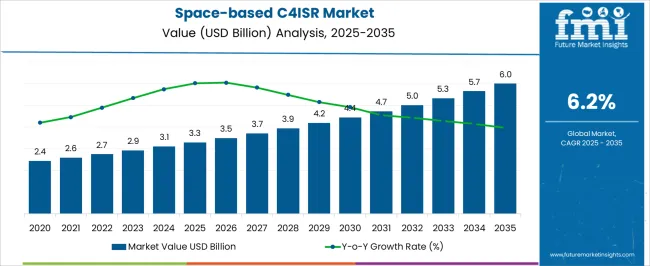
| Metric | Value |
|---|---|
| Space-based C4ISR Market Estimated Value in (2025 E) | USD 3.3 billion |
| Space-based C4ISR Market Forecast Value in (2035 F) | USD 6.0 billion |
| Forecast CAGR (2025 to 2035) | 6.2% |
The satellite communication market is the largest contributor, accounting for approximately 30-35%, as space-based C4ISR systems rely heavily on secure and reliable satellite communications for global data transmission. The demand for secure communication systems, particularly in military and defense sectors, plays a significant role in the growth of this market. The defense and military electronics market follows with around 25-30%, as C4ISR systems are vital for modern defense operations, providing critical command, control, communications, and surveillance capabilities. The increasing reliance on advanced military electronics to improve tactical operations drives demand for space-based C4ISR solutions.
The aerospace and defense market contributes about 20-25%, as space-based C4ISR plays a crucial role in military missions, strategic defense, and national security. As investments in space-based assets and defense technologies increase, so does the demand for space-based C4ISR systems. The global positioning system (GPS) market accounts for approximately 10-12%, as GPS satellites are integral to the tracking, navigation, and surveillance capabilities of space-based C4ISR systems. Finally, the cybersecurity market contributes around 8-10%, as the protection of satellite communications and sensitive data exchanges becomes a priority for military and defense organizations.
The space-based C4ISR market is expanding rapidly, driven by escalating geopolitical tensions, increased defense spending, and growing emphasis on real-time situational awareness. Integration of advanced communication, surveillance, and reconnaissance systems into satellite-based platforms is enhancing strategic decision-making and operational effectiveness.
Nations are investing heavily in space-based assets to strengthen their defense posture, ensuring uninterrupted data flow across command centers and frontline units. Technological advancements such as AI-driven analytics, miniaturization of payloads, and enhanced encryption are reshaping the competitive landscape.
Looking ahead, the market is expected to benefit from deeper collaborations between government space agencies and private aerospace firms, particularly in developing secure and interoperable architectures. As modern warfare increasingly relies on data precision and global reach, space-based C4ISR systems are becoming indispensable to national security frameworks, ensuring long-term market relevance and investment interest
The space-based c4isr market is segmented by type, platform type, end use, and geographic regions. By type, space-based c4isr market is divided into Command and Control (C2), communications, computers and data processing, and ISR. In terms of platform type, space-based c4isr market is classified into satellite, unmanned spacecraft, and space-based sensors and payloads. Based on end use, space-based c4isr market is segmented into defense and military organizations, homeland security, civil and government, and commercial applications. Regionally, the space-based c4isr industry is classified into North America, Latin America, Western Europe, Eastern Europe, Balkan & Baltic Countries, Russia & Belarus, Central Asia, East Asia, South Asia & Pacific, and the Middle East & Africa.
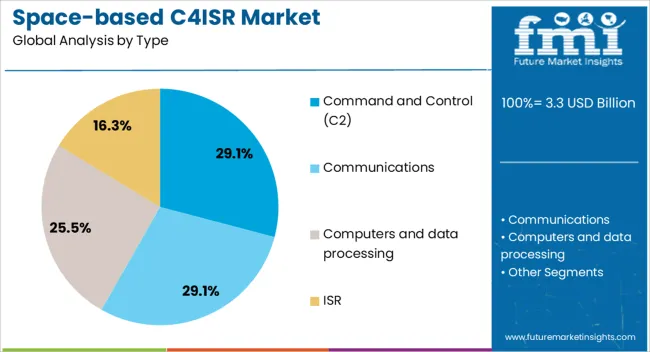
The command and control (C2) segment leads the market by type with a 29.1% share, reflecting its critical role in coordinating operations across distributed military assets and platforms. This segment is central to enabling real-time decision-making, situational awareness, and interoperability across air, land, sea, and space domains.
Enhanced reliance on satellite-linked C2 frameworks is driven by the need for seamless mission planning, threat assessment, and strategic command execution. The segment benefits from continuous upgrades in secure communication protocols and modular, software-defined systems that ensure scalability and resilience.
Global defense forces are prioritizing investment in space-based C2 infrastructure to maintain dominance in modern warfare scenarios. As cyber threats intensify and battle spaces become more digitized, the C2 segment is poised to retain its strategic significance, supported by policy mandates and joint-force operational doctrines

The satellite segment dominates the platform category with a 34.7% market share, underscoring its indispensable function in enabling space-based C4ISR capabilities. Satellites provide persistent coverage, high-resolution imaging, and secure communication channels essential for surveillance, reconnaissance, and command coordination.
The surge in deployment of small satellites and low Earth orbit (LEO) constellations has enhanced data transmission speed and reduced latency, reinforcing the segment’s growth. Governments and private defense contractors are increasingly launching purpose-built military satellites tailored for specific C4ISR functions.
Cost reductions in satellite manufacturing and launch services further encourage deployment at scale. As multi-domain operations become standard in defense planning, satellites will continue to serve as the backbone of space-based intelligence infrastructure, ensuring continuity, accuracy, and strategic advantage across national security missions

Defense and military organizations account for 48.3% of the end-use segment, marking them as the primary stakeholders in the space-based C4ISR ecosystem. Their reliance on space-based systems stems from the demand for real-time battlefield visibility, secure communications, and integrated intelligence streams.
Heightened focus on modernizing defense capabilities and preparing for near-peer conflicts has led to increased funding and accelerated procurement of satellite-enabled command systems. These organizations are leading adopters of integrated C4ISR frameworks that offer rapid responsiveness and operational synchronization across various domains.
Geopolitical rivalries and asymmetric warfare scenarios are reinforcing the importance of resilient space-based assets. Future investments by defense ministries and allied coalitions are expected to further cement the role of military end users in shaping the trajectory of this market, particularly through long-term contracts and collaborative development initiatives
C4ISR systems play a critical role in modern military and intelligence operations, providing essential data for situational awareness, decision-making, and coordination of complex operations. The market is driven by advancements in satellite technologies, the growing importance of national security, and the increasing adoption of space-based platforms for military operations. However, challenges such as the high costs of space infrastructure, the need for secure communications, and the complexity of integrating space systems with terrestrial assets may impede market growth. Opportunities exist in satellite miniaturization, emerging space defense programs, and the integration of AI and data analytics to enhance operational capabilities.
Space-based C4ISR systems are critical for providing real-time intelligence, surveillance, and reconnaissance data, allowing defense agencies to monitor global threats, track enemy movements, and manage military operations efficiently. These systems offer unparalleled coverage and operational flexibility, making them an essential component of modern military forces. The growing threat of cyber-attacks, geopolitical instability, and evolving defense challenges are pushing governments to invest in advanced space-based technologies that can provide strategic intelligence and improve the effectiveness of defense operations. The demand for space-based surveillance, communication, and command capabilities is expected to continue rising as countries enhance their defense capabilities.
The development, launch, and maintenance of satellites and other space infrastructure require significant financial investments. Maintaining secure and uninterrupted communication channels in space is a major challenge, as these systems are vulnerable to cyber-attacks, jamming, and other security threats. Governments and military organizations are focusing on strengthening cybersecurity measures to safeguard sensitive data transmitted through space-based systems. Furthermore, integrating space-based C4ISR systems with terrestrial military assets, such as ground stations, mobile platforms, and command centers, is complex and requires sophisticated communication protocols. These challenges create barriers to market growth but also present opportunities for companies that offer secure, scalable, and cost-effective solutions for space-based defense systems.
The space-based C4ISR market presents significant opportunities in satellite miniaturization and the integration of artificial intelligence (AI) for enhanced decision-making and operational efficiency. Miniaturized satellites, often referred to as smallsats, are providing a more cost-effective solution for deploying space-based C4ISR systems. These smaller, lighter satellites are easier and cheaper to launch and maintain while still offering advanced capabilities for surveillance and communication. Additionally, AI and machine learning technologies are being integrated into space-based C4ISR systems to improve data analysis, pattern recognition, and predictive capabilities. AI can significantly reduce the time required to process vast amounts of data, allowing defense agencies to make faster, more informed decisions in real-time. Companies that focus on smallsat technology and AI integration are well-positioned to capture growing market opportunities.
The space-based C4ISR market is experiencing trends in the development of space-based defense programs and the shift toward multi-domain operations. As global military strategies evolve, there is an increasing need for integrated, cross-domain operations that combine space, air, land, sea, and cyber capabilities. Space-based C4ISR systems are becoming central to these multi-domain operations, enabling military forces to communicate and coordinate seamlessly across different theaters of operation. Additionally, the growing focus on space defense programs—designed to protect satellites and other space assets from adversaries—has led to advancements in space situational awareness and active defense technologies. These trends are creating new growth opportunities for companies that specialize in space-based defense systems, satellite protection, and cross-domain operational capabilities.
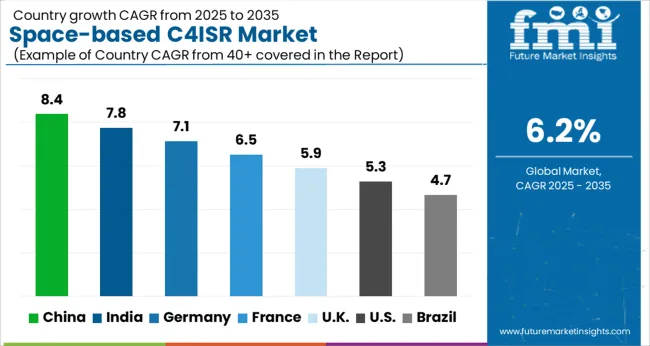
| Country | CAGR |
|---|---|
| China | 8.4% |
| India | 7.8% |
| Germany | 7.1% |
| France | 6.5% |
| UK | 5.9% |
| USA | 5.3% |
| Brazil | 4.7% |
The global space-based C4ISR market is projected to grow at a CAGR of 6.2% from 2025 to 2035. China leads with a growth rate of 8.4%, followed by India at 7.8% and Germany at 7.1%. The UK and USA show moderate growth rates of 5.9% and 5.3%, respectively. The market is driven by increasing defense needs, modernization of military capabilities, advancements in satellite infrastructure, and the rising demand for real-time intelligence, communication, and surveillance systems. Geopolitical tensions and evolving security threats continue to fuel the adoption of space-based C4ISR systems globally. The analysis spans over 40+ countries, with the leading markets shown below.
The space-based C4ISR (Command, Control, Communications, Computers, Intelligence, Surveillance, and Reconnaissance) market in China is projected to grow at a CAGR of 8.4% from 2025 to 2035. The country’s increasing focus on strengthening its military capabilities and enhancing its satellite infrastructure is driving the demand for advanced space-based C4ISR systems. China’s growing investment in space technology and defense modernization is promoting the development and deployment of these systems for intelligence gathering, surveillance, and national security. With rising geopolitical tensions and the need for improved situational awareness, space-based C4ISR systems are becoming critical to China’s defense strategy. The Chinese government’s continued efforts to enhance its satellite constellation, coupled with advancements in communication technologies, are expected to further fuel market growth.
The space-based C4ISR market in India is expected to grow at a CAGR of 7.8% from 2025 to 2035. India’s growing defense needs, coupled with the increasing adoption of advanced space-based technologies, are key drivers for the market. The Indian government’s focus on strengthening its defense capabilities, particularly through the development of satellites and communication systems, is fueling the demand for C4ISR systems. These systems play a critical role in enhancing national security by enabling real-time surveillance, intelligence gathering, and communication for the military. India’s increasing investments in space infrastructure and satellite systems, as well as its rising defense budget, are expected to contribute significantly to the growth of the market. Strategic collaborations with other nations for defense and space technology will further support the adoption of space-based C4ISR systems.
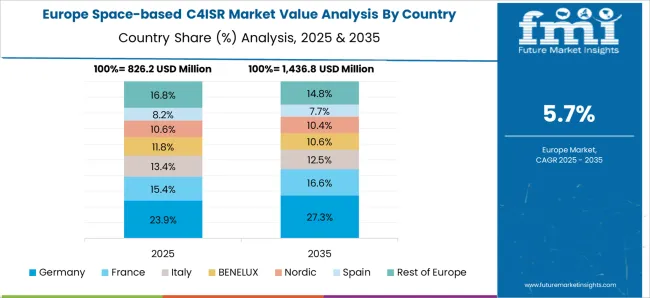
The space-based C4ISR market in Germany is projected to grow at a CAGR of 7.1% from 2025 to 2035. Germany’s commitment to modernizing its military capabilities and expanding its role in space-related defense technologies is driving the demand for space-based C4ISR systems. As part of its broader defense strategy within NATO, Germany continues to invest in advanced communication and surveillance technologies that ensure real-time monitoring and intelligence sharing. Germany’s collaboration with other European nations for satellite constellations and space exploration further accelerates the adoption of space-based C4ISR systems. The country’s increasing focus on enhancing national security and maintaining an edge in space defense technologies contributes significantly to the market growth.
The UK space-based C4ISR market is expected to grow at a CAGR of 5.9% from 2025 to 2035. The UK has been increasingly focusing on improving its space-based defense systems as part of its military modernization efforts. With growing concerns over national security and defense, the demand for space-based C4ISR systems is expected to increase, especially for applications related to surveillance, reconnaissance, and real-time communications. The UK government has also been investing in advanced satellite systems and defense technologies to enhance its military capabilities. The country’s collaborations with NATO and other defense organizations for shared intelligence systems are further driving the adoption of C4ISR systems.
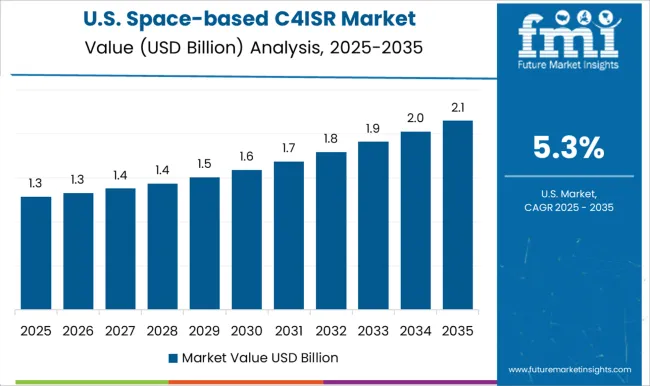
The USA space-based C4ISR market is projected to grow at a CAGR of 5.3% from 2025 to 2035. As a global leader in military and space technologies, the USA continues to invest heavily in space-based systems to maintain its strategic advantage in defense and intelligence gathering. The increasing complexity of global security threats, coupled with the USA military’s need for advanced satellite communication, surveillance, and reconnaissance systems, is driving the demand for space-based C4ISR technologies. The USA Department of Defense’s ongoing efforts to enhance its satellite infrastructure and capabilities are expected to be key growth drivers. Additionally, the integration of new technologies, including AI and data analytics, into space-based C4ISR systems is expected to further elevate market growth.
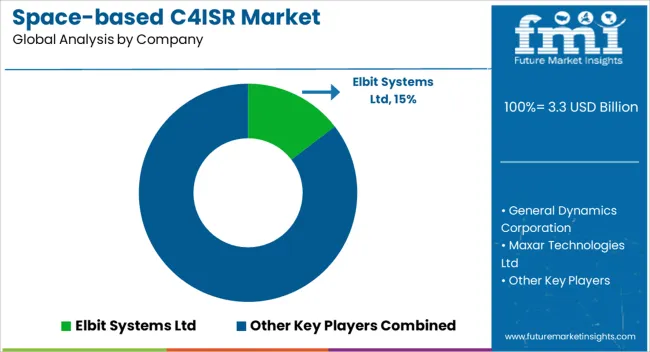
The space-based C4ISR (Command, Control, Communications, Computers, Intelligence, Surveillance, and Reconnaissance) market is intensely competitive, with key players focusing on providing cutting-edge satellite communications, intelligence gathering, and surveillance solutions for defense and security applications. Elbit Systems Ltd competes by offering advanced space-based systems designed to enhance situational awareness and decision-making for military forces. Their solutions are integrated with high-performance sensors and communication systems, ensuring reliable and secure data transmission. General Dynamics Corporation focuses on providing secure and resilient space-based communication solutions for defense applications, emphasizing system interoperability and real-time data exchange across global networks.
Maxar Technologies Ltd stands out in the market with its high-resolution satellite imaging and geospatial intelligence solutions, enabling military forces to monitor critical areas and make informed decisions. Lockheed Martin Corporation is a major player, specializing in space-based platforms that integrate command and control, communications, and intelligence systems. Their products are known for high reliability and are used in missions that require continuous, real-time data for tactical advantage. Northrop Grumman Corporation offers advanced satellites and payloads designed for C4ISR applications, with a focus on multi-domain operations and data fusion for rapid decision-making. BAE Systems PLC competes by providing satellite communication and surveillance technologies that support global military operations, with emphasis on cybersecurity and system resilience in contested environments. CACI International Inc. offers comprehensive C4ISR solutions, including software and integrated systems that enhance situational awareness and operational efficiency. Kratos Defense & Security Solutions Inc. focuses on providing agile and scalable satellite solutions, particularly for unmanned spacecraft and fast-deploying defense systems.
The Boeing Company and L3Harris Technologies Inc. are strong contenders in the market, offering advanced satellite systems for intelligence and communications in defense sectors. Boeing’s solutions are tailored for large-scale, complex military operations, while L3Harris focuses on secure communications and integrated intelligence systems. Hanwha Systems Co. Ltd brings competitive solutions with a focus on high-tech surveillance satellites and command systems for defense applications. Product brochures from these companies highlight capabilities like real-time data transmission, high-resolution imagery, multi-sensor integration, and secure communications. Emphasis is placed on flexibility, scalability, and the ability to operate in dynamic, multi-domain environments, ensuring that space-based C4ISR systems can support critical missions in defense, intelligence, and security.
| Item | Value |
|---|---|
| Quantitative Units | USD 3.3 billion |
| Type | Command and Control (C2), Communications, Computers and data processing, and ISR |
| Platform Type | Satellite, Unmanned spacecraft, and Space-based sensors and payloads |
| End Use | Defense and military organizations, Homeland security, Civil and government, and Commercial applications |
| Regions Covered | North America, Europe, Asia-Pacific, Latin America, Middle East & Africa |
| Country Covered | United States, Canada, Germany, France, United Kingdom, China, Japan, India, Brazil, South Africa |
| Key Companies Profiled | Elbit Systems Ltd, General Dynamics Corporation, Maxar Technologies Ltd, Lockheed Martin Corporation, Northrop Grumman Corporation, BAE Systems PLC, CACI International Inc., Kratos Defense & Security Solutions Inc., The Boeing Company, L3Harris Technologies Inc., and Hanwha Systems Co. Ltd |
| Additional Attributes | Dollar sales by product type (satellites, ground systems, communication systems, sensors), application (defense, intelligence, surveillance, communications), and technology (secure communications, advanced sensors, data analytics). Demand dynamics are driven by the increasing need for advanced military surveillance, secure communications, and intelligence gathering, as well as the growing importance of space-based assets for national security. Regional trends show significant growth in North America and Europe, particularly in military defense programs, with rising investments in space-based technologies by governments and defense agencies. The Asia-Pacific region is also witnessing a surge in space-based C4ISR technologies, driven by regional security concerns and advancements in defense systems. |
The global space-based c4isr market is estimated to be valued at USD 3.3 billion in 2025.
The market size for the space-based c4isr market is projected to reach USD 6.0 billion by 2035.
The space-based c4isr market is expected to grow at a 6.2% CAGR between 2025 and 2035.
The key product types in space-based c4isr market are command and control (c2), communications, computers and data processing and isr.
In terms of platform type, satellite segment to command 34.7% share in the space-based c4isr market in 2025.






Full Research Suite comprises of:
Market outlook & trends analysis
Interviews & case studies
Strategic recommendations
Vendor profiles & capabilities analysis
5-year forecasts
8 regions and 60+ country-level data splits
Market segment data splits
12 months of continuous data updates
DELIVERED AS:
PDF EXCEL ONLINE
C4ISR Market Size and Share Forecast Outlook 2025 to 2035
Air-Based C4ISR Market Size and Share Forecast Outlook 2025 to 2035

Thank you!
You will receive an email from our Business Development Manager. Please be sure to check your SPAM/JUNK folder too.
Chat With
MaRIA